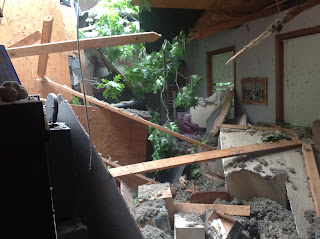Does it look to you as though a T. Rex might have wandered by and taken a big bite out of my roof?
That would be a much more interesting story than what really happened. In actuality, on Monday evening while my family was eating supper, a big oak tree from my neighbor's backyard fell onto/into my house.
Some of the garden was smashed, too.
We were sitting in this room when it happened:
Of course, pre-tree there was a lot less stuff lying around, and we didn't have the enormous "skylight" letting so much sunshine and greenery into the house.
The good news is that my little family is fine. We are only scraped and bruised, and the animals all seem to be fine, too. One of the dogs had to be helped out by the Cobb County Firemen who responded to my 911 call, and we will be forever grateful for their help. We were worried when she yelped and then struggled to get up but couldn't. Luckily, even though she was trapped under some debris, she wasn't seriously injured. At first we couldn't find the cat, but he had taken refuge upstairs.
The worst damage was in the dining room, so it is a good thing that we were being lazy, eating in the living room and watching TV. If we had been in the dining room, the disaster would have been more tragic than crazy. The table and chairs in there were buried (and broken) under some very heavy boards, roof supports, and branches.
People keep asking about the storm that must have brought the tree down, but there was no storm. That night, we had no wind, no rain until several hours after the event. The tree was brought down by gravity and probably the damage that results from several years of drought conditions. The root mass that came up at the far end of the tree didn't seem even close to large enough to hold up a 100-foot trunk and the associated big bunch of greenery. I can only guess that roots had been dieing, year after year, until they just could no longer hold the tree.
Some parts of my garden in the front yard were obliterated. The new patch of green beans is gone, as is the entire patch of parching corn that my son had asked me to grow. This is one of those times when the flexibility of gardeners is useful - I will just plan to try that corn again next year, because it is definitely too late to replant that particular variety this summer.
Even it weren't too late, my seeds were all packed up by a cleaning company, and I don't know when I'll get them back, so it looks like I won't be starting the Brassica-family plants this weekend as I had originally planned. For the most part, I will have to rely on the garden supply stores for the fall garden. That's OK. The available varieties won't be the ones I had selected, but they will work just fine.
In other good news, I have been reminded of how many amazing friends and neighbors I have. Several of my neighbors are storing my frozen garden produce in their freezers; another neighbor brought cardboard boxes late on Monday night and helped load up the things we thought we'd need for the upcoming week; one friend is keeping one of our dogs and another has the rabbits; one brought us lunch on Tuesday as we waited on the driveway for the next crew of workmen; one is serving as "communications central," sending out email updates to a large group of gardeners; others are waiting to find out what we need next. Of course, events at the house are unfolding at the speed of the Insurance Industry, so it's all in fits and starts with odd lulls and then spurts of activity.
I am getting the feeling that the pace of recovery overall is going to be annoyingly slow, but I keep thinking back to the miracle that we are all fine. The whole set of events has made me think of other miracles, like the one of Moses getting his people out of Egypt. The miracle (really a whole string of Divine Interventions) was followed by forty years of Work - plodding, annoying, and quarrel-inducing. In fact, the Work part seems to follow every miracle that I can recall. So, I've had my miracle, and now there is some work ahead. Remind me, when I complain, that my work part of this miracle is going to be a whole lot less than forty years!
















